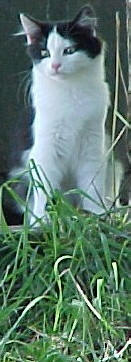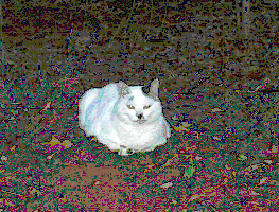 Why do some gardeners consider cats a pain in the neck in their gardens?
Why do some gardeners consider cats a pain in the neck in their gardens?
Cats sometimes dig up newly planted bulbs, eat prize plants, and attack birds and butterflies that you want in your garden. But the positives far
outweigh the negatives.
What are the positives?
Cats help keep the population of voles, mice, rats, and chipmunks down. Longwood Gardens in Pennsylvania actually has cats on their payroll, as part
of their Integrated Pest Management team! And never underestimate the value of cat urine, which is extremely high in nitrogen and perfect for leaves about to be composted.
Why create a special garden space for cats?
Giving cats their own garden space-complete with catnip, a bowl of water, and a comfortable place to sleep-helps keep the cats out of flower beds and
vegetable plots. They'd rather hang out in the catnip, roll in the dirt, and sleep in the sun. They're happy in their own little space.
 Where should the cats' garden space be planted?
Where should the cats' garden space be planted?
Location, location, location! Cats love sun, so plant their garden spaces in full sun, and add a bowl of water and something comfortable for them to
sleep on, such as a bench or patio swing. Also, try to locate it in a corner of the yard away from your favorite plants and flowers.
What plants should be included in the cats' garden?
There are many plants to choose from. Some popular and easy choices are catnip (Nepeta cataria), catmint (Nepeta mussinii), valerian, and, of course,
some cat grasses.
Are catnip and catmint easy to grow in Frederick?
Yes. They both like full or partial sun and well-drained soil. Both are deer resistant, and neither is considered invasive in Maryland. Catnip grows
about a foot high, and produces tiny lavender flowers in the summer. Catmint can grow up to 3 feet tall and has small white or lilac flowers in summer. Both are beautifully
fragrant in the summer garden, and attract lovely butterflies. And catnip is a rat deterrent.
 Do all cats respond to catnip?
Do all cats respond to catnip?
Eighty-five percent of domestic cats respond biochemically to catnip, specifically to nepetalactone, the essential oil in catnip and catmint.
Nepetalactone induces harmless physiological reactions, including psychosexual responses in both male and female cats, which is why it is considered an aphrodisiac. The other
fifteen percent do not respond at all to nepetalactone, because they didn't receive the catnip response gene from their mother. Young kittens almost never respond to catnip,
regardless of their genes.
Are domestic felines the only ones who respond to catnip?
No. Some of the large cats, including cougars, bobcats, lions and lynx, respond to nepetalactone as well.
Is it true that cats love having their own salad bars?
Yes, cats naturally crave grasses. Grasses provide roughage and lots of vitamins, especially folic acid. Grasses aid a cat's digestion and assist in
removing fur balls.
So you may want to grow some special cat grasses in their garden space, or just leave a patch of about 3 square feet of unmowed grass for them to
munch on. They will love eating it and hiding in it.
How can indoor cats benefit from any of this?
For indoor cats, be sure to grow some special cat grasses for them, which will keep them from devouring your house plants, some of which may be
poisonous. And grow catnip for them outdoors and present them with a fresh stem every few days. It will have the same euphoric effect as if they were rolling around in it
outdoors.
Are there certain plants that should not be planted in the cats' garden space?
Yes. Plants that can be poisonous to cats should be avoided. They include azaleas, chrysanthemums, daffodils, hydrangeas, iris, ivy, lantana,
marigolds, and wisteria. Tiger lilies are particularly poisonous to cats, and can cause death.
Sometimes gardeners want to keep cats out of their yards. What can they do to keep them away?
There are several natural cat repellents that are safe and easy to use. For example, spraying a vinegar-and-water solution around the base of your
acid-loving plants or putting lemon and orange peels around your plants will keep cats away. Putting pebbles, gravel, or small, upright twigs among your plants will also keep
their sensitive paws away. Some plants such as the scented geranium, the mosquito plant, and citronella, will also deter cats.
The best choice is a coleus nicknamed "Scaredy Cat" (Coleus canina). It's a bit pricey but its strong aroma, which is triggered by touch or the sun,
keeps cats-and dogs-away. You can plant it in a container and then move it around the garden, protecting different areas of the garden from animals. It has clusters of blue
flowers that also give off the strong aroma.
Happy gardening to you and your feline friends!
Read other articles on garden and landscape design
Read other articles by Joanne Brown